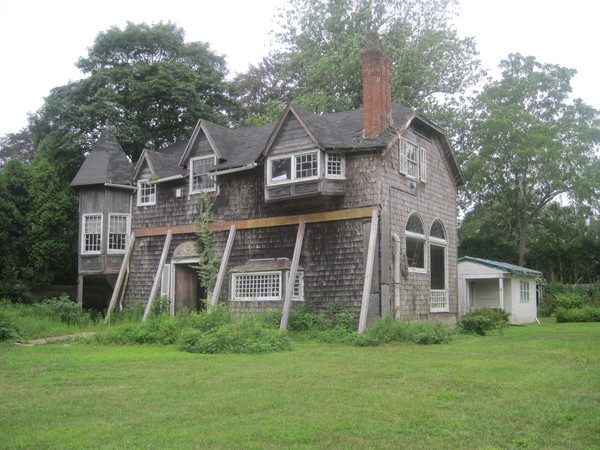
Nestled in the heart of East Hampton, across from Town Pond, is an unassuming old, deteriorating house that some would dismiss as just that. But in reality, this 125-plus-year-old Queen Anne-style shingle is considered one of the most important legacies of American art and cultural history.
The Thomas Moran and Mary Nimmo Moran Studio House was designed and built in 1884 by Thomas Moran, one of America’s premier landscape artists. The painter, who lived in East Hampton for 40 years, achieved fame in 1872 when his larger-than-life artwork, “The Grand Canyon of the Yellowstone,” was the first painting ever to be purchased by Congress for the U.S. Capitol Building. Ms. Moran was an artist and printmaker.
Most recently, last month the Thomas Moran Trust was awarded a $5,000 grant by the National Trust for Historic Preservation from its Cynthia Woods Mitchell Fund for Historic Interiors. The money was designated to be used for the restoration of the studio room in the house, where Mr. Moran frequently worked.
“One of the National Trust for Historic Preservation’s main concerns was the quality of expertise involved in the study,” said Thomas Moran Trust Executive Director Marti Mayo, who added that fundraising and restoration efforts have been ongoing since the trust formed in 2007. “They recognized that our restoration is one that will conform to the standards set by the U.S. Department of Interior. We are delighted to be chosen because we know that the guidelines are strict and exacting.”
According to Phyllis Braff, who also sits on the Thomas Moran Trust Board, the $5,000 grant has a very specific job.
“It will go toward a historic finishes report to accurately determine the interior finishes, including color, character, stains of historic woodwork, historic wallpaper, cloth coverings and more.”
In the late 19th and early 20th centuries, East Hampton was a bustling artists colony, and the Morans’ home became a central part of that emerging culture, according to Ms. Mayo. She noted that the trust is a non-profit organization dedicated to restoring and revitalizing the property, which was once a residence and bustling social hub but now sits vacant and in need of repair.
“The studio room was not only used as Mr. Moran’s workspace,” Ms. Mayo said. “It was also a center of intellectual and community life here in East Hampton.”
As for the more recent history of the house, in 1950 the Moran family sold the property to Elizabeth and Condie Lamb, who continued to use the home as a place of social, cultural and artistic celebration. The property was declared a National Historic Landmark and placed on the National Register of Historic Places in 1965.
Not only was the property as a whole recognized as a landmark, the main room in the house, known as “the studio,” was also landmarked separately. It is much less common for a room to be landmarked than for the exterior of a property to receive that distinction.
Elizabeth Lamb, who gifted the house to Guild Hall in East Hampton, lived there until her death in 2004. At that time, Guild Hall took possession of the house, but then transferred ownership to the newly-formed trust in 2007.
According to Ms. Braff, what the landmark distinction means is that all restoration work must conform to the highest standards of the U.S. Department of Interior. Additionally, the trust must take careful measures to make sure the studio room, which as an interior must meet stricter restrictions, is restored to exactly how it was in 1916. That year was chosen as a date of significance for the restoration since Mr. Moran made no structural changes to the house after that time. Ms. Braff added that the exterior of the house will be restored to as it was in 1916 as well.
“A landmark designation is the highest honor that the United States Department of Interior can offer,” she added. “A distinction of this kind is reserved for properties that exemplify significant aspects of America’s history. And the fact that this property was registered in 1965, soon after the program was created, is remarkable.”
Before the restoration work can begin on the studio room, the mandatory interior analysis needs to be completed. That analysis will be conducted by Mary Jablonski of Jablonski Building Conservation in Manhattan. The investigation will then be reviewed by the New York State Historic Preservation Office and the National Park Service.
Following the interior investigation, Dobbs Ferry-based architect Stephen Tilly and his architectural team will begin the actual restoration, Ms. Mayo reported.
“Stephen Tilly is a pure joy, knowledgeable and careful. Just what we needed,” Ms. Mayo said. “They are restoration experts.”
Going forward, there are clear guidelines that the trust must follow. The work must be in accordance with East Hampton Village guidelines as well as the state and federal mandates.
“The project is driven by a need to be authentic,” Ms. Mayo said. “The village feels strongly that we need to maintain Mr. Moran’s story and keep the property forever as it should be.”
Mr. Mayo and Ms. Braff said they both feel like the trust has a strong foundation to continue moving forward.
“The community and regional enthusiasm has been great,” Ms. Mayo said. “Through events and generous community members, we are going to be able to accomplish our mission to do something very exciting for this historic community.”
Ms. Mayo said that it will take approximately $8 million to restore the property, approximately $3.5 million of which has been raised to date. She noted that the trust is also accepting donations for the restoration.
For more information about the Thomas Moran Trust, visit thomasmorantrust.org.